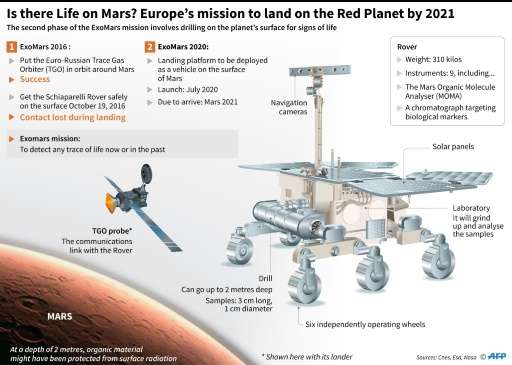Two possible landing sites for ExoMars mission

The ExoMars mobile rover, tasked with recovering evidence of life on the Red Planet, will touch down in 2021 at one of two sites, scientists announced Wednesday.
"After intense discussions, we have voted for the sites Oxia Planum and Mawrth Vallis," Frances Westhall, head of research at the Center for Molecular Biophysics in Orleans, France, told journalists.
The final decision—to be made a few months before the 2020 lauch—will in some ways pit scientists against engineers: one site is more varied geologically, while the other is less rocky, and thus easier for the rover to navigate.
Both locations, however, are rich in clay, which makes them promising environments "that may contain traces of past life," said Westhall, a member of the Mars Analogue for Space Exploration (MASE) consortium.
"We like clay because it attracts organic matter and preserves it."
Life forms are unlikely to exist on Mars' barren, radiation-blasted surface.
But traces of methane in the planet's atmosphere suggest something may have once stirred under the surface, possibly single-celled microbes.
The multi-billion dollar mission will look for signs of life from Mars ancient past when it had water, at least 3.6 billion years ago.
The compact car-sized rover—equipped with a drill, wheels and legs—is designed to execute eight excavations over a six month period, travelling a total of a dozen kilometres (seven or eight miles) in the process.
And the winner is...
It will dig to a depth of two metres (six feet) twice, and to a depth of 1.5 metres (four-and-a-half feet) six times.
Onboard instruments will analyse the samples to look for signs of past life.
One problem, however, is that scientists are not sure what they are looking for.
Unlike Earth, Mars essentially lacks oxygen, an essential ingredient for most life on our planet.
To anticipate what microscopic fossils of anaerobic organisms on the Red Planet might look like, Westhall and her team did experiments.
"In the laboratory, we tried to duplicate the likely conditions of ancient Mars in terms of temperature, mineral composition and atmosphere," she said.
The candidate landing sites are cratered, and at low altitudes, to ensure that the rover's parachute will have time to open properly.
The two-part mission saw a spacecraft successfully placed into orbit in mid-October, but a companion lander designed to pave the way for a mobile-lab rover in 2020 smashed into the planet's surface.
So will it be Oxia Planum or Mawrth Vallis?
"There is always a tug-of-war between the engineers and the scientists, because the latter want to go where things are interesting, and the former are generally more interested in a safe landing," Westhall joked.
© 2017 AFP




















